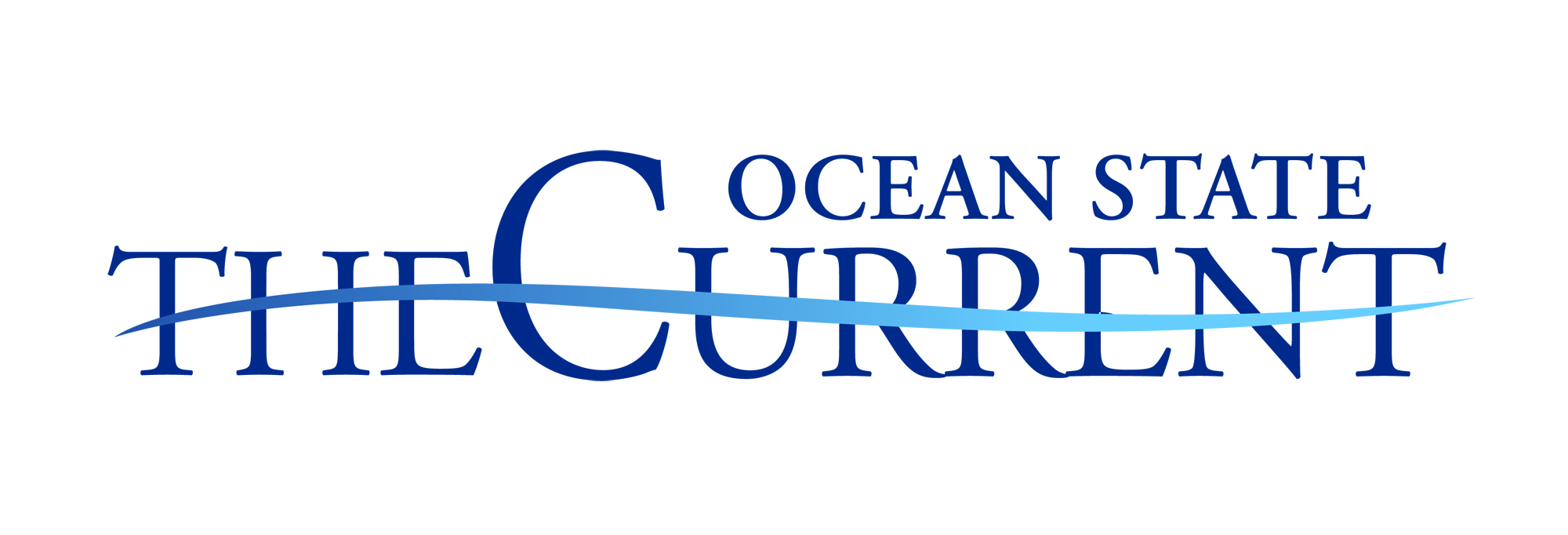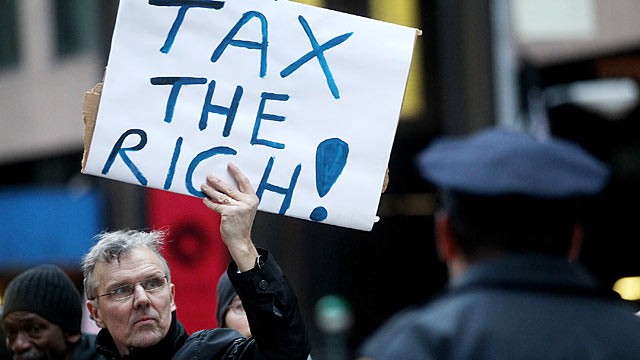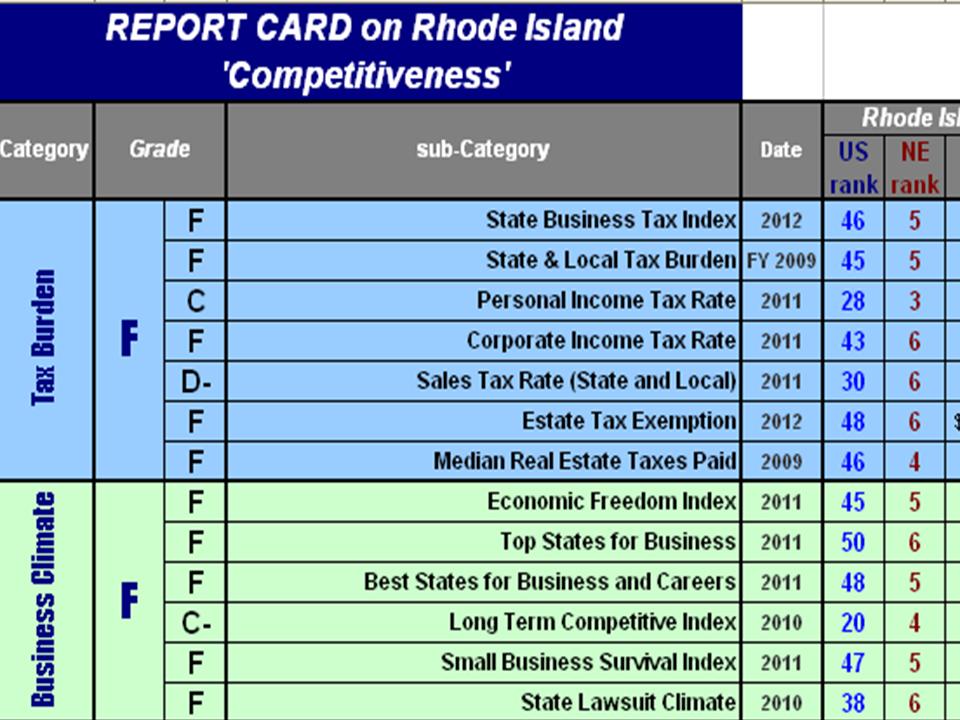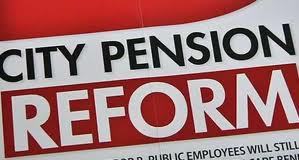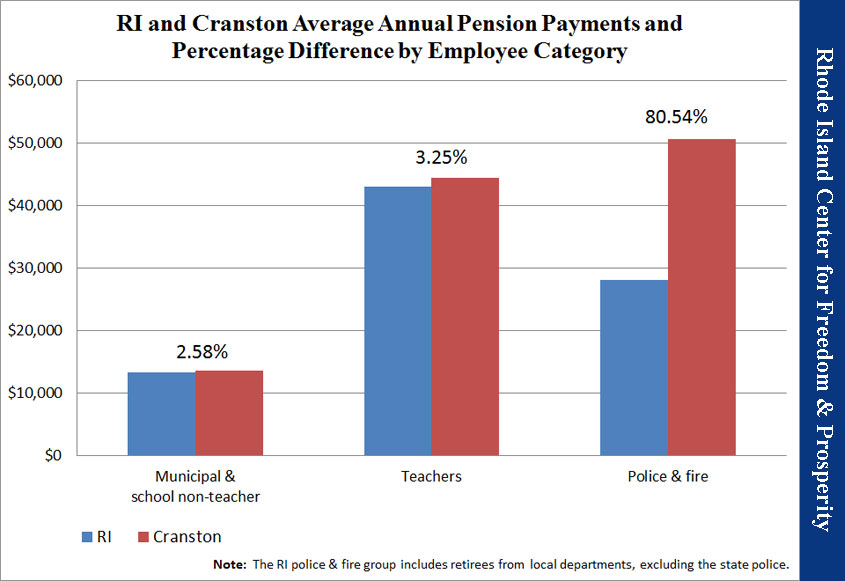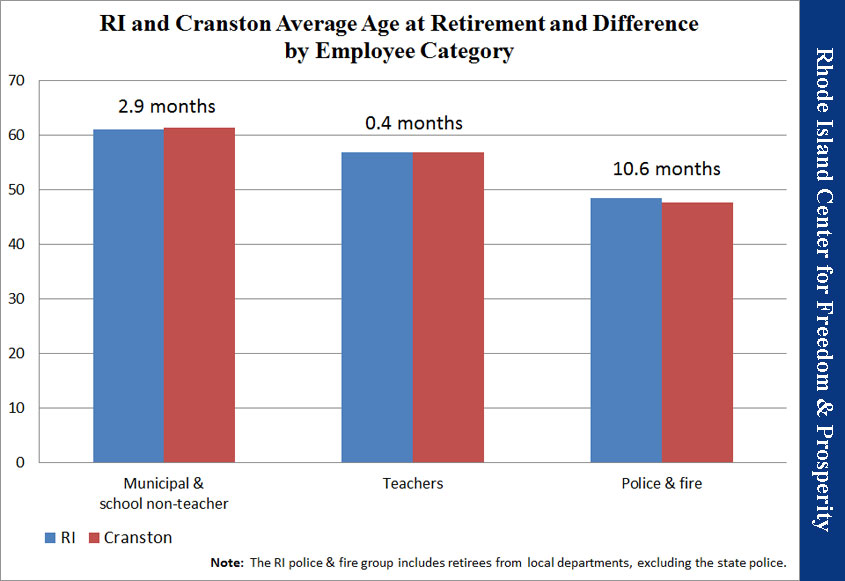Freedom of Association for Ocean State Workers
Introduction
Today, in 23 states in America, workers have the freedom under “Right-to-Work” (RTW) laws to decide whether or not to pay union dues. Indiana became the twenty-third state on that list in February of 2012, bringing the workers of the Hoosier State renewed hope in an economy that has seen few glimmers of light.
Rhode Islanders are suffering from a severely weak economy and our state needs to seek every competitive opportunity it can in order to attract and grow jobs. As demonstrated by the Report Card on Rhode Island Competitiveness[1], by many measures, Rhode Island is excessively uncompetitive in both New England and nationally, when it comes to growing and attracting business and high-paying, sustainable jobs.
One of the single most effective ways to provide the Ocean State with a new competitive edge is passing Right-To-Work legislation. Indiana earned itself a major competitive advantage by becoming the only state in the Rust Belt to enact a Right-To-Work law.
Policy Recommendation
Rhode Island should become the 24th Right-To-Work state as part of a larger agenda to re-invigorate the state economy. RTW would give the Ocean State a major advantage over its neighbors by making it the only New England state with RTW protections for its citizens–without costing the state a dime in revenue.
Rhode Island must act now – while there is still an advantage to gain. New Hampshire is actively considering RTW legislation and the debate has begun in other New England states as well.The Ocean State cannot afford to also lag behind in this vital policy area, which can be a catalyst for job growth… nor can Rhode Island workers wait.
Background
Compared to the rest of New England, notwithstanding the rest of the country, the Rhode Island economy is not competitive. According to our Center’s recently released Competitiveness Report Card, Rhode Island scores an F in five out of ten major categories, including “Tax Burden” and “Business Climate.” The Ocean State can rebound from this extended economic slump, and should begin its recovery by undoing one of the greatest impediments to both progress and liberty: compulsory unionism.
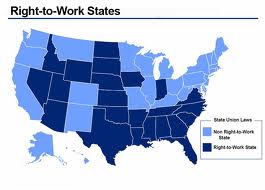
Despite the anti-worker propaganda from the union leadership who depend on mandatory dues to fund their own multi-million dollar enterprises, passing RTW legislation in Rhode Island will not suddenly ban unions or allow unsafe or exploitative business practices. On the contrary, RTW legislation is not an attack on organized labor, but rather provides a framework that restores the rights of workers to choose whether or not they wish to be in a union.
Simply stated, it allows workers the choice to either affiliate with a union and pay dues, or to opt out of the union system.
RTW legislation typically includes eliminating onerous laws and regulations that pressure workers — overtly or otherwise — to join unions whether or not they feel it is within their best interests. Under a RTW measure, workers would be protected from being fired or harassed if they choose not to pay union dues.
According to Mike Brownfield of the Heritage Foundation:
“It’s understandable that states would want the benefits that Right-to-Work brings, but it’s also understandable why unions oppose it so strongly. When Idaho and Oklahoma passed Right-to-Work laws, union membership fell 15 percent. Likewise, the forced dues payments the unions collected plummeted right along with their membership. Right-to-Work would put money directly into the pockets of private-sector workers.”[2]
RTW is only a danger to unionism as an industry of ‘political’ machinery, not to the idea of unionism itself. And in the process of restoring the basic civil liberties of Rhode Island workers and allowing them to decide for themselves about union membership …
… RTW would make Rhode Island far more economically competitive and will increase economic freedom for its citizens.
Freedom and Prosperity
Most importantly, RTW is about individual freedom. Robert Barro, a professor of economics at Harvard University and a senior fellow at Stanford University’s Hoover Institution, notes that while unions were originally subject to antitrust legislation in the late 19th century, savvy politicking by organized labor was able to obtain exemptions in the early 20th century. And subsequently, unions were able to use this exemption to negotiate “union shop” laws, which essentially forced workers to join unions.
“From the standpoint of civil liberties,” notes Barro in a Wall Street Journal Op-Ed, “the individual right to work—without being forced to join a union or pay dues—has a much better claim than collective bargaining.”[3]
Depriving workers of their right of association is both undemocratic and economically ruinous. The ability of unions to use their unique and virtually unassailable leverage in states where unionism is mandatory has — as the devastation of the automotive and railroad industries well-underline[4] — extracted such concessions from private industries (and, in some cases, the public) to handicap economic growth, raise unemployment, and stultify necessary technological innovation.
In times of massive capital investments in factories and machinery, these negative effects were small compared to the cost of factory relocation, but in this global and post-industrial economy such assets are essentially portable, and a shift to a lower cost labor environment is viewed as a sound business practice rather than an insurmountable hurdle. That means slower growth and lost jobs.
Multiple studies have confirmed the relationship between forced unionism and negative growth and, conversely, the relationship between right to work and positive economic growth:
Manufacturing Growth: One study found that “cumulative growth of employment in manufacturing (the traditional area of union strength prior to the rise of public-employee unions) in the right-to-work states was 26 percentage points greater than that in the non-right-to-work states.”[5]
New Business Growth: Another study, published by the Office of Senator Jim DeMint (R), clearly shows that despite representing only 40.3 percent of the U.S. population, Right-to-Work states can claim almost 60 percent of new business growth between 1993 and 2009.[6]
Gross State Product Growth: Arthur B. Laffer and Stephen Moore noted in the Wall Street Journal last year, “[o]ver the past decade (2000-09) the right-to-work states grew faster in nearly every respect than their union-shop counterparts: 54.6% versus 41.1% in gross state product, 53.3% versus 40.6% in personal income, 11.9% versus 6.1% in population, and 4.1% versus -0.6% in payrolls.”[7]
Job Growth: James Sherk of the Heritage Foundation found RTW is good for jobs: “Right-to-work states are much more attractive for businesses investment. Unionized firms earn lower profits, invest less, and create fewer jobs than comparable nonunion firms . . . of neighboring counties on state borders with and without right-to-work laws . . . manufacturing jobs in counties in right-to-work states is one-third higher than in adjacent counties in non–right-to-work states. Right-to-work laws attract jobs.”[8]
Migration Gains: Richard Vedder, the Edwin and Ruth Kennedy Distinguished Professor of Economics at Ohio University, examines the national movement of people and economic growth toward RTW states and concludes: “The proportion of Americans living in right-to-work states has risen noticeably over the years, and only a small part of that is driven by new states adopting such laws. People move in extraordinary numbers to right-to-work states from states where union pressure has prevented the adoption of such laws. Moreover, the greater flexibility for workers and employers offered where right-to-work exists has contributed to higher rates of economic growth rates in the right-to-work environment.”[9]
Wage Growth: W. Robert Reed have found that RTW leads to both greater employment and higher wage growth.[10] [11]
Finally, RTW creates higher wages. According to Paul Kersey at the Mackinac Institute: “Then there is the cost of living, which tends to be lower in right-to-work states. A study by the Missouri Economic Research and Information Center found that in 2009, after adjusting for the cost of living, annual per-capita disposable income was $35,543 in right-to-work states, compared to $33,389 in non-right-to-work states. That equates to a $2,154 premium each year for those living in right-to-work states.”[12]
There is no question that Rhode Island could certainly use the clear competitive advantage that RTW would bring–a much needed economic shot in the arm.
Reduces Corruption of the Political Process
Disproportionate union power is not only troubling from the standpoint of individual liberty and economic prosperity, but also when considering the integrity of the political system. Union dues, which are often collected via intrusive anti-worker forced unionization laws, are often recycled through a system that has essentially allowed Big Labor to throw its institutional and financial support to the candidates they choose: inevitably, those that endorse or at least comply with their monopolistic tendencies.[13]
For Rhode Island, which continues to suffer from the extended doldrums of the economic crisis, the business-as-usual approach to public policy needs to come to an end. Making the Ocean State a Right-To-Work state is an excellent way to begin and to improve competitiveness immediately while making great strides for civil liberty and political integrity.
A longstanding majority (in fact, a super-majority for many decades now) of Americans support a worker’s right to choose whether to join a union[14], a fact that is perhaps reinforced by the dwindling numbers of private sector unions. It is illustrative of the money and power at stake in this political debate when we consider that less than half of U.S. states are RTW despite the clear preferences of the public.
Conclusion
Rhode Island desperately needs to initiate comprehensive and fundamental public policy reform if it hopes to regain its competitive status. One of the furthest-reaching and simplest reforms that would not cost the state a dime would be to pass Right-To-Work legislation.
With Right-To-Work comes significant and demonstrable economic benefits — a shot in the arm that the Ocean State economy badly needs — but also the restoration of what is a fundamental civil right of workers … freedom of association.
By nearly every measure shown in our Report Card on Rhode Island Competitiveness, the Ocean State is not competitive nationally and within New England. However, passing RTW legislation would allow the state the chance to be immediately competitive and worthy of a strong look by businesses and investors looking at the northeast.
The positive impact of worker choice in other states has been clearly demonstrated, and 23 states now see the benefit of worker freedom to their economies. For Rhode Island, the benefits and the urgency is clear: now is the time to do the ‘right’ thing.
* * *
This Policy Brief was jointly developed and co-edited by Giovanni Cicione (Senior Policy Advisor to the Center) and J. Scott Moody (Adjunct Scholar to the Center), with research by Michael Cecire (Policy Analyst for the Center).
Download a printable version of this Policy Brief here …
End Notes

